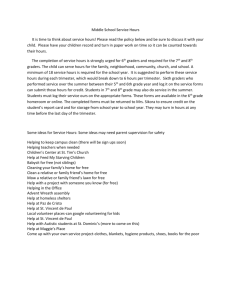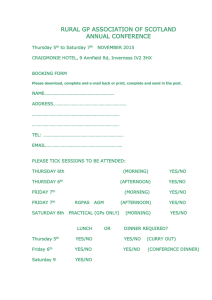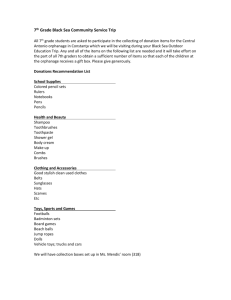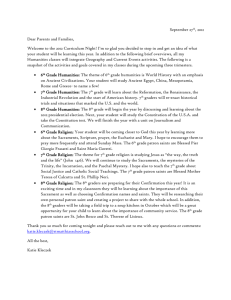biol 336 coastal environments tentative class schedule
advertisement
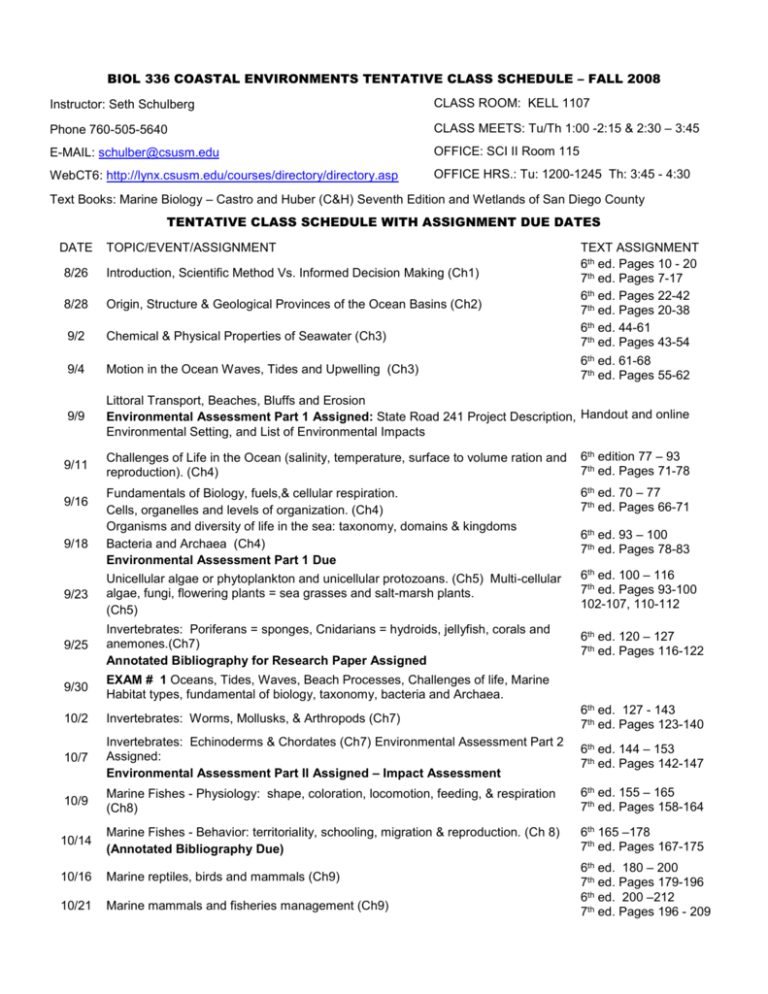
BIOL 336 COASTAL ENVIRONMENTS TENTATIVE CLASS SCHEDULE – FALL 2008 Instructor: Seth Schulberg CLASS ROOM: KELL 1107 Phone 760-505-5640 CLASS MEETS: Tu/Th 1:00 -2:15 & 2:30 – 3:45 E-MAIL: schulber@csusm.edu OFFICE: SCI II Room 115 WebCT6: http://lynx.csusm.edu/courses/directory/directory.asp OFFICE HRS.: Tu: 1200-1245 Th: 3:45 - 4:30 Text Books: Marine Biology – Castro and Huber (C&H) Seventh Edition and Wetlands of San Diego County TENTATIVE CLASS SCHEDULE WITH ASSIGNMENT DUE DATES DATE 8/26 Introduction, Scientific Method Vs. Informed Decision Making (Ch1) 8/28 Origin, Structure & Geological Provinces of the Ocean Basins (Ch2) 9/2 Chemical & Physical Properties of Seawater (Ch3) TEXT ASSIGNMENT 6th ed. Pages 10 - 20 7th ed. Pages 7-17 6th ed. Pages 22-42 7th ed. Pages 20-38 6th ed. 44-61 7th ed. Pages 43-54 9/4 Motion in the Ocean Waves, Tides and Upwelling (Ch3) 6th ed. 61-68 7th ed. Pages 55-62 9/9 Littoral Transport, Beaches, Bluffs and Erosion Environmental Assessment Part 1 Assigned: State Road 241 Project Description, Handout and online Environmental Setting, and List of Environmental Impacts 9/11 Challenges of Life in the Ocean (salinity, temperature, surface to volume ration and reproduction). (Ch4) 6th edition 77 – 93 7th ed. Pages 71-78 Fundamentals of Biology, fuels,& cellular respiration. Cells, organelles and levels of organization. (Ch4) Organisms and diversity of life in the sea: taxonomy, domains & kingdoms Bacteria and Archaea (Ch4) Environmental Assessment Part 1 Due Unicellular algae or phytoplankton and unicellular protozoans. (Ch5) Multi-cellular algae, fungi, flowering plants = sea grasses and salt-marsh plants. (Ch5) 6th ed. 70 – 77 7th ed. Pages 66-71 9/25 Invertebrates: Poriferans = sponges, Cnidarians = hydroids, jellyfish, corals and anemones.(Ch7) Annotated Bibliography for Research Paper Assigned 6th ed. 120 – 127 7th ed. Pages 116-122 9/30 EXAM # 1 Oceans, Tides, Waves, Beach Processes, Challenges of life, Marine Habitat types, fundamental of biology, taxonomy, bacteria and Archaea. 10/2 Invertebrates: Worms, Mollusks, & Arthropods (Ch7) 6th ed. 127 - 143 7th ed. Pages 123-140 10/7 Invertebrates: Echinoderms & Chordates (Ch7) Environmental Assessment Part 2 Assigned: Environmental Assessment Part II Assigned – Impact Assessment 6th ed. 144 – 153 7th ed. Pages 142-147 10/9 Marine Fishes - Physiology: shape, coloration, locomotion, feeding, & respiration (Ch8) 6th ed. 155 – 165 7th ed. Pages 158-164 10/14 Marine Fishes - Behavior: territoriality, schooling, migration & reproduction. (Ch 8) (Annotated Bibliography Due) 6th 165 –178 7th ed. Pages 167-175 10/16 Marine reptiles, birds and mammals (Ch9) 10/21 Marine mammals and fisheries management (Ch9) 9/16 9/18 9/23 TOPIC/EVENT/ASSIGNMENT 6th ed. 93 – 100 7th ed. Pages 78-83 6th ed. 100 – 116 7th ed. Pages 93-100 102-107, 110-112 6th ed. 180 – 200 7th ed. Pages 179-196 6th ed. 200 –212 7th ed. Pages 196 - 209 10/23 Ecological Principals (Community structure, population growth, species interaction, trophic structure & energy flow. Ch 10. Environmental Assessment Part II Due 10/28 EXAM # 2 Marine Life from algae through invertebrates through fishes. 10/30 Ecological Principals (Community structure, population growth, species interaction, trophic structure & energy flow. Ch 10. 6th ed. 215 – 234 7th ed. Pages 211 - 230 11/4 Marine Habitat - Life between the tides - hard bottom. Biological Zonation and adaptation to life in the coastal zone (Ch11) (Wetland FTX Assigned) 6th ed. 235 –244 7th ed. Pages 242-250 11/6 Marine Habitat - Life between the tides – soft bottom Ch. 11 6th ed. 244 – 258 7th ed. Pages 250-263 11/13 Estuaries & lagoons – their physical & biological characteristics (Ch12) 6th ed. 259 – 276 7th ed. Pages 265 - 281 Wetlands of SD County 11/18 Resources from the sea and fisheries management. (Ch17) Fish Sheet Assigned 6th ed. 377 – 420 7th ed. Pages 379-401 Handout 11/20 Fisheries Management: Regional Planning Process, MMPAs and the government agencies involved. Env. Assess. Part lll: Discussion of State Route 241 at San Onofre 6th ed. 377 – 420 7th ed. Pages 379-401 Handout 11/25 The impact of humans on the marine environment and resource protection legislation acts: CZMA, NEPA, CEQA, MMPA & the CA Coastal Act (Ch18) Env. Assess. Part lll: Discussion of State Route 241 at San Onofre 6th ed. 402 – 422 7th ed. Pages 402 - 420 12/2 The impact of humans on the marine environment and resource protection legislation acts: CZMA, NEPA, CEQA, MMPA & the CA Coastal Act (Ch18) Wetland FTX Due 6th ed. 402 – 422 7th ed. Pages 402 - 420 12/4 Loose Ends and Review Fish Sheet Due Research Paper Due Final Exam 12/11 12/9 6th ed. 215 – 234 7th ed. Pages 211 - 230 1:45 – 3:45 1:45 – 3:45 Section 1 Section 2 FIELDTRIPS: 1. 9/13 & 14 (Sat.Sun) South Carlsbad State Beach - Beaches, Bluffs and Erosion 2. 11/22 & 23 (Sat/Sun) Batiquitos Lagoon for Wetland FTX REQUIRED ASSIGNMENTS & EXAMS Date Due 1 Item Random Quizzes and in-class writing (5 worth 10 points each) 50 points or 5% 9/18 Env. Assessment Part I – Project description, Env. setting and list of potential impacts associated with State Rd. 241 50 points or 6% 9/30 Exam 1 Ocean Basins, plate tectonics, waves, littoral transport, challenges of life, taxonomy, bacteria and Archaea. 100 points or 12% Percent of Fin. Grade 10/14 11/20 Annotated Bibliography on research paper topic due. Fifteen 100 points or 12% references in CBE style. (4 newspaper, 5 popular science magazines and 6 peer review journals or govt. reports 50 points or 6% Env. Assessment Part II – Summary of potential impacts and discussion of significance and potential mitigation Exam 2 Marine life flowering plants, invertebrates, fish and marine 100 points or 12% mammals 50 points or 5% Env. Assessment Part III – Class discussion and debate 12/2 regarding State Road 241 and associated env. Impacts. Wetland Field Training Exercise 100 points or 12% 12/4 Research Paper (5 pages double spaced) 100 points or12 % 12/4 Fish Sheet 50 points or 6% 10/23 10/28 12/11 Sec 01 Exam 3 Ecological principals, fisheries & environmental 12/9 Sec 02 regulations. 100 points or 12% 850 points or 100% 1. All assignments are due at 1:00 am or 2:30 PM depending on the section you are in. After that, the assignment is considered late. Late assignments will reduced 5% for each day late, unless accompanied with medical or other sufficient justification. ALL assignments must be turned in to receive a passing grade. Typically, no make-up exams will be given, although the teacher may use his discretion. ACADEMIC HONESTY & CLASSROOM ETIQUETTE: Any evidence of cheating or plagiarism (defined as presenting words or ideas of others as your own) will result in zero points being awarded for that assignment and a failing grade for the course. If you work as a team, please identify all team members on each members individual submittal. Please come to class on time. You are responsible for all information discussed in class. Please do not talk while another person is speaking, it disturbs others around you. Please do not sleep during class. GRADES: The guaranteed course grading scale is 90-93% = A-, 93- 100% = A, 80-82% = B-, 83 – 87% = B, 88 - 89% = B+, 70-72% = C- 73-77% = C, 78-79% = C+ 60-62% = D-. 63-67% = D, 68-69% = D+, below 60% = F. I may curve grades to fit this distribution. I have no predetermined grade frequency distribution: I can give all A's as easily as all F's or any combination in between. Students are not in competition with each other.
